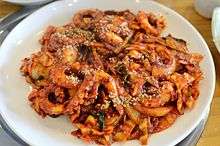Nakji-bokkeum
Nakji-bokkeum[1] (낙지볶음) or stir-fried octopus[1] is a popular dish in Korea that is relatively recent, with origins only dating back two centuries and first being introduced in 1965.
 | |
| Alternative names | Stir-fried octopus |
|---|---|
| Type | Bokkeum |
| Place of origin | Korea |
| Main ingredients | Long arm octopus |
| Korean name | |
| Hangul | 낙지볶음 |
|---|---|
| Revised Romanization | nakji-bokkeum |
| McCune–Reischauer | nakchi-pokkŭm |
| IPA | [nak̚.t͈ɕi.bo.k͈ɯm] |
History
The origins of nakji bokkeum date back to the 19th century, where octopus was either consumed raw, dried, or pan-fried. Dishes such as nakjisukhoe (leached octopus) and nakjibaeksuk (boiled octopus) were served during the 20th century, with octopus being consumed more frequently and proven to have health benefits, dishes with octopus were being developed such as yeonpotang (pellucid octopus soup) and nakji-bibimbap (mixed rice with octopus and vegetables).
Granny Park Mu-Sun is believed to be the creator of the dish, which was nicknamed as Mugyo-Dong. She first revealed the dish at a tavern at Korean Export Insurance Corporation in Seorin-dong, Seoul in 1965. Soon, restaurants adopted the dish and because of the large demand of the dish, she opened a branch named Nakji Center in 1972.
In Korea, nakji bokkeum is served spicy so people usually eat shellfish soup with it to reduce the sensation of hotness. Mugyo-dong in Seoul has been famous for its delicious nakji bokkeum restaurants since the 1960s.
Preparation
Nakji bokkeumi is made with chopped octopus and vegetables such as onions, green onions, cabbage, and carrots. Then make a marinade with gochujang (red pepper paste), soy sauce, garlic, salt and sugar. Then mix the octopus and vegetables together, and then marinade them. Finally, fry everything together. Octopus is a low-calorie food, so it is believed to be good for stamina. Nakji bokkeum is usually served with jogaetang (clam stew) in order to enrich the taste of the dish.
See also
References
- (in Korean) "주요 한식명(200개) 로마자 표기 및 번역(영, 중, 일) 표준안" [Standardized Romanizations and Translations (English, Chinese, and Japanese) of (200) Major Korean Dishes] (PDF). National Institute of Korean Language. 2014-07-30. Retrieved 2017-02-22. Lay summary.